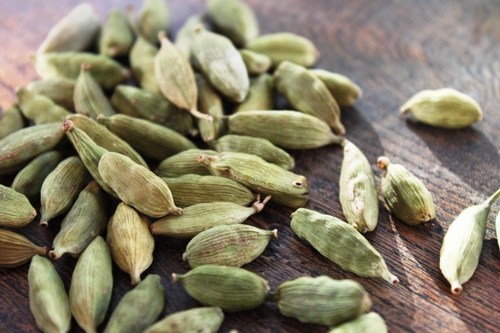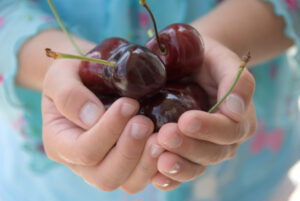
Virgil Evetts
I always liked cardamom well enough. I’d throw a few pods in a pot of rice or add them ground to an unctuously cashew-rich korma, but mostly because that’s what I was taught to do. I didn’t dwell much on the spice’s subtle charms and myriad virtues. But in a moment akin (I presume) to realising that the love of your life has been right in front of you all along, I discovered through a single rushed and improvised dessert the true nature of my feelings for cardamom – love, pure and simple.
Cardamom is the common name for the dried seed pods of two distantly related members of the ginger family Elettaria cardamomum or Green Cardamom and Amomum subulatum Black cardamom. With its dense, smoky flavour the latter has its uses to be sure ,but it’s lovely, pistachio-green cardamom with which I’m so deeply smitten.
Green cardamom is a strictly tropical plant (trust me, I’ve tried) grown commercially in India and parts of South East Asia. Tradition has it that the best quality cardamom comes from the hills of Kerala, India’s famed spice capital. As a crop cardamom is fickle and low-yielding. Individual plants can grow to several metres tall but individually produce very small quantities of pods. These must be picked at an exact stage of development and dried quickly (often in charcoal ‘kilns’) at a low, steady heat. The whole process is extremely labour intensive, and any errors of judgement can ruin an entire harvest.
As one of the world’s most labour intensive spices, it is only India’s low labours costs that make it even remotely practical to produce. If cardamom was produced in New Zealand it would surely cost more than gold.
The price of cardamom is also kept high by a massive international demand. Apart from its importance in Indian cooking, the spice is also used extensively in Europe (especially in Scandinavia and Germany), and is considered an essential ingredient in coffee throughout the Arab world. Cardamom is also in demand on an industrial scale by producers of alcoholic drinks- particularly high-end gins and bitter liqueurs or amari.
Cardamom should always be used freshly ground, from seeds extracted from plump green pods. Do not buy loose seeds as they loose intensity very quickly and avoid pre-ground cardamom which is composed mostly of pod husks rather than seeds. Three or four whole pods are enough to delicately flavour an entire pot of rice, and a couple added to an Indian curry can be the difference between transcendence and mediocrity.
Although we tend to think of cardamom as a curry spice, in India it’s just as well known as flavouring for sweets and desserts. Only when coupled with sweetness is the lovely resinous fragrance and delicate flavour of the spice fully revealed. It is at once pervasive and haunting, with notes of pistachio, rose, citrus and ylang ylang. Truly a spice for aesthetes and artists.
I’ve tried my hand at a few cardamom desserts over the years, including Antonio Carluccio’s sublime Cardamom Gelato, my own Christmas Stollen, and a disastrous attempt at barfi; but my favourite to date is the following Steamed Pudding. I adapted the recipe from that of a Malaysian Nonya steamed caramel cake, replacing the volatile burnt sugar syrup of the original with honey. On a last minute whim I added a generous quantity of freshly ground cardamom, mostly because it was leftover from the previous nights curry and I didn’t want it to go to waste. The resulting pudding/cakelet was a thing of subtle beauty-sweet but not cloying, gorgeously dense and richly honeyed, all wrapped up a delicate cloud of cardamom. We ate dessert in the happiest of silences that night.
Cardamom & Honey Steamed Pudding
This is a very forgiving recipe and is effectively impossible to overcook. Don’t worry if the puddings burst open like flowers in the steamer- this is quite normal. Once cooked the puddings can be kept covered in the fridge for up to two weeks, and re-heated in the microwave without any loss of flavour or moistness.
Ingredients
¾ cup honey
½ cup water
80 grams butter (melted)
¾ cup milk
1 egg
1 ½ cups plain flour
1 heaped tsp baking powder
¼ cup white sugar
2 tsp freshly ground cardamom
Method
In small pan bring the honey and water to a boil. Simmer briefly and remove from heat.
Bring a large pot of water to the boil, over which a steamer (big enough to hold about 4 ramekins) can be fitted.
Sift the flour, baking powder, cardamom and sugar into a mixing bowl.
Beat together the egg, milk, melted butter with the cooled honey syrup.
Briskly combine wet and dry ingredients. Do not over-work the batter.
¾ fill buttered ramekins with batter and place in steamer (covered) over boiling water. Do not open steamer again for 20 minutes. Steam for 30 minutes in total or until a skewer inserted into the centre of the largest pudding comes away clean.
Serve hot with pouring cream or a little vanilla ice cream




I don’t see why not Ruth. Microwaves work really well for steaming.
Hi Virgil
Can you microwave this pudding, say in a round ring dish.
Have fun.
Ruth
You’ve shown me up Lorna!
As a beekeeper I have so much honey that I never even glance at prices in the supermarket anymore. I do know that it was bad year for commercial bee keepers though. Poor flowering in many crops and lots of rainy days…
Aaah. The stunning taste when biting on a cardamom pod in a curry. Fantastic.
I love cardamom too, and have always hoped that someone would use it as an unforgettable note in a scent. I find it very hard these days to source pods which yield fresh glossy black seeds which should clump together (looking like rat dirt). I have to discard so many disappointing pods. I will definitely try the pudding recipe. I used to make a cardamom and orange ice cream which was stunning – but that was in the days of Culpeppers in Newmarket.
Lovely sounding dessert, Virgil, but it must surely be bordering on one to be served only on very special occasions. Why? Because have you noticed the price of honey lately? I know that some manuka honey has special healing properties but I think everyone is jumping on the bandwagon and charging exorbitant prices for the product. It no longer features regularly in my diet, I’m sad to say.